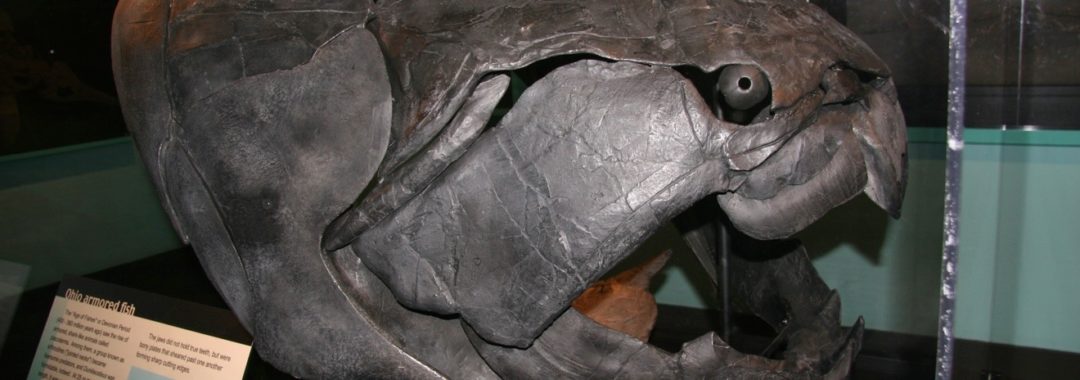
CMC Blog
The Fossil Fish That Could
By: Glenn W. Storrs, Ph.D., Withrow Farny Curator of Vertebrate Paleontology
On December 21, 2020, Governor Mike DeWine signed Ohio Senate Bill No. 123 into law, thus designating Dunkleosteus terrelli as the Fossil Fish of Ohio. Not every state needs an official fossil fish, of course, but if you had to have one, Dunkleosteus (Dunk–ul–AHS–tee–us) might well be it, and no fish is more deserving when it comes to Ohio. Named for David Dunkle, former curator at the Cleveland Museum of Natural History, this giant predator is best known from Late Devonian age rocks, approximately 360 million years old, in northeastern Ohio, but also occurs in similar rocks in central and southern Ohio, Kentucky, Indiana, Tennessee, western Pennsylvania and New York, Missouri, and as far afield as California, Canada, Belgium, Poland and Morocco.
With upper estimates of 6-9 meters (20-30 feet) in length and several tons in weight, Dunkleosteus was a formidable presence in the shallow, subtropical, Late Devonian sea covering our region at that time. Belonging to a group of fish, now entirely extinct, called placoderms (literally “plate skin”), it was a predatory animal in the subgroup known as arthrodires (“jointed neck”). Placoderms include some of the first vertebrates to have evolved functioning jaws, and the arthrodires are further notable for the large bony plates that lay within and beneath the skin, protecting their head and shoulder regions. The internal skeleton including the braincase, vertebral column and fin supports were cartilaginous and thus are rarely preserved.
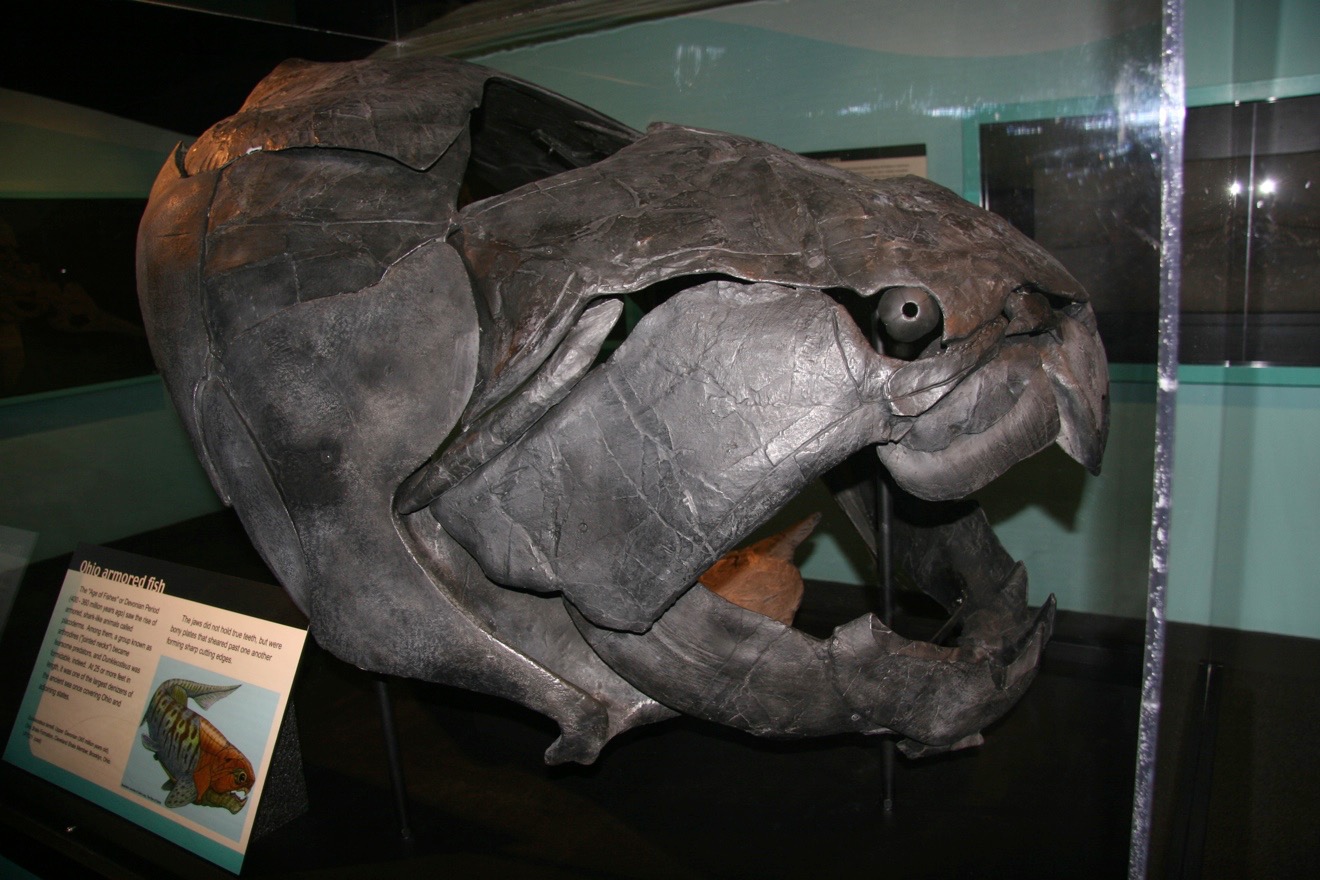
Mounted cast of Dunkleosteus head and thoracic armor as previously displayed at Cincinnati Museum Center.
Particularly remarkable in Dunkleosteus, however, are the large, powerful jaws and bony “tusks” that give this fish such a fearsome appearance. Although true teeth appear to have been present in younger individuals, these were typically ground away with age, leaving sharp opposing edges of bone as the functional cutting surfaces of the upper and lower jaws. These jaws of bone sliced against one another like the blades of a scissors, maintaining a sharp edge, while the “tusks” at the front gave the animal the appearance of a monstrous staple remover!
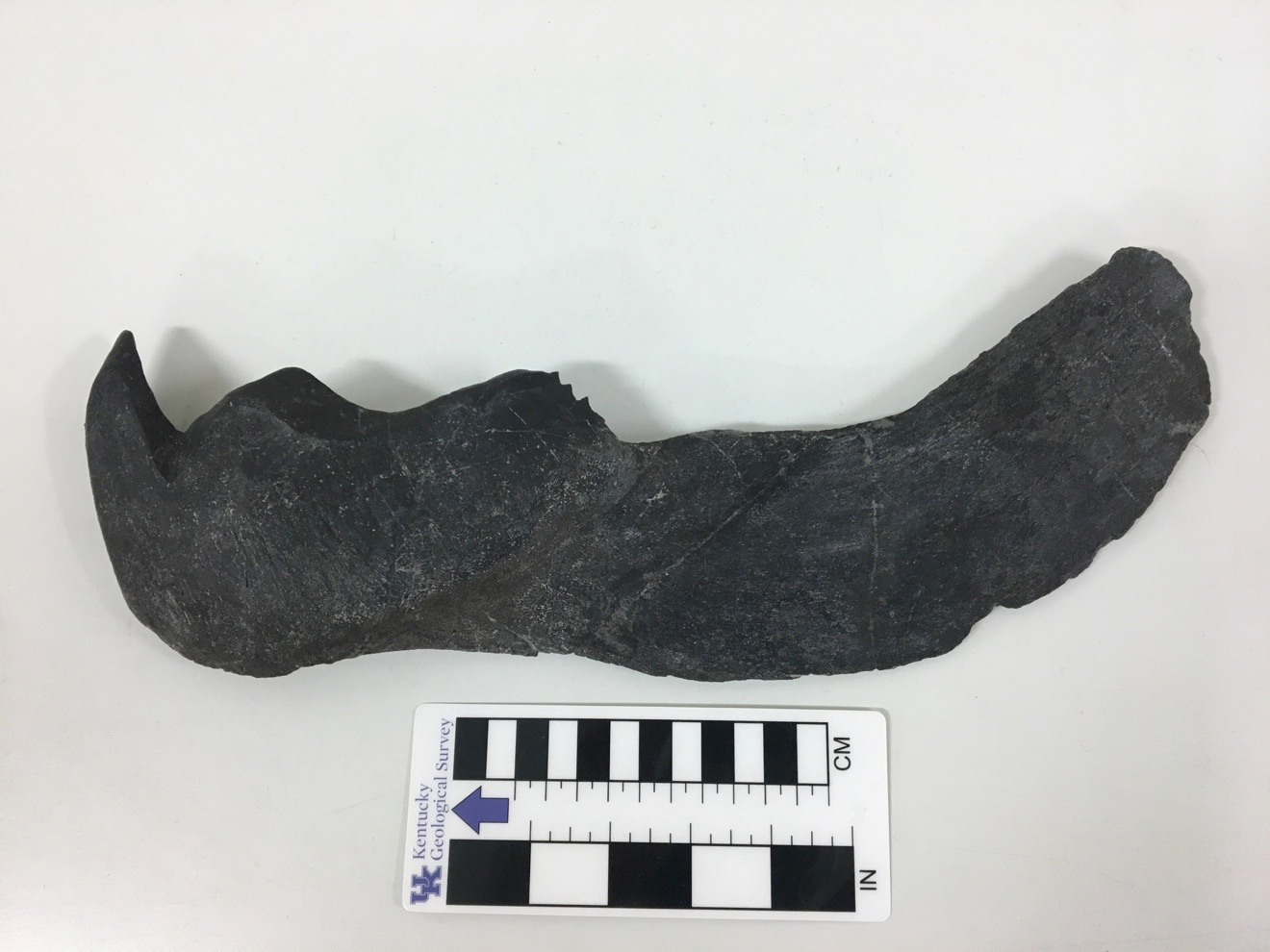
Dunkleosteus infragnathal (lower jaw) plate. Note “tusk” and sharp, beveled edge.
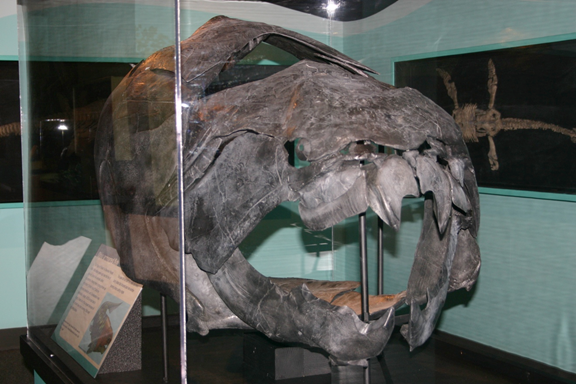
Cincinnati Museum Center’s Dunkleosteus mount showing “staple remover” jaws to good advantage!
What to do with such jaws? Clearly Dunkleosteus preyed upon other fish, surely including the early shark Cladoselache (KLAD–oh–sell–ACHE–ee), that swam alongside it in the Devonian sea, but it’s also clear that it attacked and consumed other arthrodires including smaller “dunks!” Direct evidence of this activity is preserved in two fossils in the collection at Cincinnati Museum Center. One of these is a lump of macerated arthrodire bone that has been through the digestive tract of a big predator, presumably Dunkleosteus. The lump is either a coprolite, in other words fossil feces, or a vomite – you can guess at what that is. In either case it indicates the predator’s diet via the remains of a meal – that is, the undigested bits. The other fossil of note is one of the bony plates from the neck region of a medium-sized Dunkleosteus. It has been bitten in two, with the halves folded upon themselves, and the bite marks from the jaws of a larger “dunk” clearly visible!
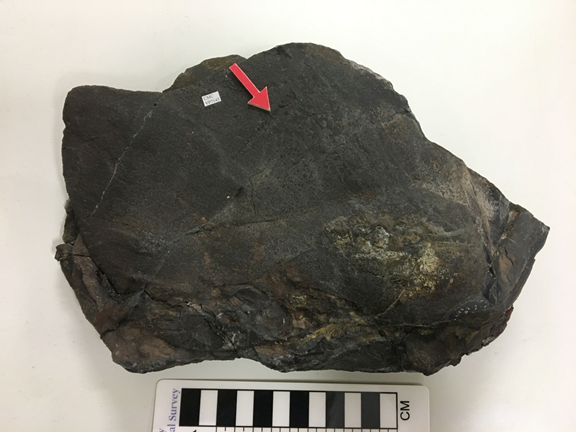
Dunkleosteus armor plate with bite mark indicated by arrow.
This month, the Ohio Department of Natural Resources announced that it hopes to install a statue of Dunkleosteus at the Ohio State Fairgrounds in its Natural Resources Park “Geological Walk Through Time.” In Cincinnati, our reconstruction of Dunkleosteus may currently be seen at Mount Saint Joseph University’s Seton Center as part of Cincinnati Museum Center’s Curate My Community effort, but will soon return to Union Terminal as part of a planned local fossil gallery. The Museum’s Champion More Curiosity campaign, now underway, will provide funds to develop and create this new museum experience, https://supportcmc.org/. The exhibit will highlight the wealth of Late Ordovician (approximately 440 million year old) marine fossils found in the Cincinnati area for which we are world-famous. CMC holds the largest and most significant collection of such fossils and will soon boast the world’s most spectacular exhibit of them. Nevertheless, jawed fish had not yet evolved and no fish of any kind have been found in local Ordovician rocks, likely because they represent the wrong paleoenvironmental type. So why Dunkleosteus? While highlighting the Ordovician, the new exhibit will also look at “deep time” in Ohio and surrounding areas, and thus fossils from the younger Silurian, Devonian and Carboniferous (Mississippian and Pennsylvanian) geological periods will also have pride of place. Among these, a number of exquisite Dunkleosteus fossils will be found. You’ll be thankful that you are not swimming the Devonian sea!
Museum Admission
Includes Cincinnati History Museum, Museum of Natural History & Science and The Children’s Museum.
| Adult (13+): | |
| Senior (60+): | |
| Child (3-12): | |
| Member Adult: | FREE |
| Member Child: | FREE |
Members receive discounts!
Become a Member today to save on programs, exhibits and films throughout CMC.
Museum Hours
Open Thursday – Monday
10 a.m. to 5 p.m.
Closed Tuesday and Wednesday
Closed Thanksgiving Day and Christmas Day
Member’s-only early entry: Saturdays at 9 a.m.
Customer Service Hours:
Monday – Sunday, 9 a.m. to 5 p.m.
